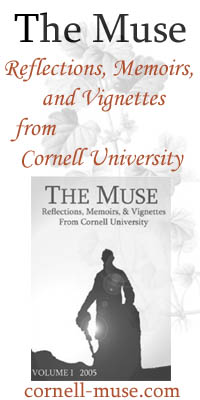Could Putting Up a Suicide Barrier Actually Cost Lives?
It is often said that virtually any method of attempting suicide substituted for jumping off a high bridge will prove less deadly. Therefore, restricting access to jumping sites will save lives. If you have followed the debates surrounding Cornell’s gorges or the Golden Gate Bridge, you’ve likely heard this point argued numerous times. But is it really true that attempting suicide from a high bridge is the most lethal of all methods?
Of course, you might say. About 98% of those who jump from the Golden Gate Bridge do not survive, and at Cornell’s gorges, that figure is about 93%.
But these percentages only account for those who actually jump, not everyone who attempts suicide at these sites. In a recent article in the Cornell Daily Sun, I wrote about two cases at Cornell, where people who were clearly intent on killing themselves in one of Cornell’s gorges were stopped by police officers who grabbed or tackled them. That got me thinking: How many people intent on jumping at Cornell or other suicide hotspots actually follow through?
Suddenly I remembered Richard Seiden’s study “Where Are They Now? A Follow-up Study of Suicide Attempters from the Golden Gate Bridge." Seiden, an advocate for suicide barriers, reported on “the 515 persons who had attempted suicide from the Golden Gate Bridge but were restrained, from the opening day through the year 1971.” His paper didn’t provide any information on the number of people who died from jumping off the bridge during that period, so I contacted Mary Currie of the Golden Gate Bridge Highway and Transportation District to see if that information was available. She sent me a year-by-year summary of confirmed suicides from the Golden Gate Bridge that she put together using hard copies of old incident reports, and I added up the figures. I found that there were 415 confirmed suicides from the Golden Gate Bridge between its opening and 1971. That suggests less than 45% of those who attempted to jump during that period were successful...
It’s important to acknowledge that this figure is far from perfect. The actual number of suicides might be higher due to suicides that were never confirmed, and the number of attempters could be lower or higher. It's hard to know if all Seiden's subjects actually would have jumped if they weren't restrained. And there may have been other cases where a member of the public talked someone down that were never recorded. But this percentage is based on numbers that Seiden and others have been comfortable using in their advocacy for barriers.
At my request, Currie also sent more recent statistics gathered between 2000 and 2010. In those eleven years, the transportation district documented 677 incidents where individuals “who may have been intending to commit suicide” on the Golden Gate Bridge were stopped by officers or other bystanders, along with 278 confirmed suicides and 59 unconfirmed suicides from the bridge. Even if we assume all the unconfirmed suicides were in fact suicides, these figures suggest that only 33% of those who went to the Golden Gate Bridge to kill themselves between 2000 and 2010 actually succeeded.
Now imagine a suicide barrier goes up (and one is planned for the Golden Gate Bridge—at a cost of $50 million). Given research at the Bloor Street Viaduct in Toronto recently published in the British Medical Journal, it seems likely that jumpers would no longer jump from that bridge, but they would substitute other similar jumping sites if they are available. None of these sites would be tourist destinations like the Golden Gate Bridge is. They may not have as many people or officers around. Will the 67% of people who are currently saved by members of the public still be saved after a barrier goes up?
One interesting thing about the Bloor Street Viaduct study in Toronto was after a barrier went up on a known suicide site, a site where some people were probably on the lookout for jumpers, the jumping suicide rate in Toronto remained the same; meanwhile the overall suicide rate went down significantly. Jumping actually became a more popular method compared to others. Could this rise in the percentage of all suicides that involved jumping actually be attributed to the barrier?
I was unable to find numbers regarding gorge suicide attempts in Ithaca, but we know there were at least two foiled attempts last year alone. Would these people have been stopped by bystanders if there were barriers that they were unable to climb on the bridges and they chose to jump from a gorge edge, just out of sight from the main path? It's possible that if the bridges were adaquately protected, these people wouldn't be alive today.
--
The risk that people will go to less protected sites isn't the only risk potentially posed by suicide barriers. If less than 33% of all the people recorded going to the Golden Gate Bridge with the intent to jump actually die, then the two leading causes of death by suicide in the U.S. are both far more lethal than America's most deadly suicide bridge. A study by Shenassa, Catlin, and Buka, published in the Journal of Epidemiol Community Health in 2003, found 96.5% of suicide attempts involving firearms were lethal, as were 90.4% of suicide attempts involving suffocation (an umbrella term including hanging). In an overview on hanging suicides published in the Journal of Epidemiology, David Gunnell and others came up with a slightly lower figure, estimating that 70% of hanging suicide attempts are lethal. These numbers don’t account for the possibility that people would be discovered in the act, but unlike jumping from a bridge, I would imagine shooting oneself or hanging oneself is usually carried out in private, so people who choose these methods are less likely to be discovered.
Clearly, some of those who do not have access to a bridge or a firearm may change their mind about killing themselves in the time it takes to acquire a gun. But it’s much less clear that this will be a large enough percentage to account for the very high lethality of guns. And the tools to hang yourself are available in every dorm, frat house, and apartment. As Gunnell et al point out, little can be done to restrict the means for hanging suicide outside of jails and mental institutions. So, clearly someone who did not consider jumping suicide because of the presence of a barrier and chose to hang themselves in a private room instead would be more likely to die than someone who attempted to jump from the Golden Gate Bridge in the past decade.
--
The lethality of going to a bridge with the intention of killing yourself could be much less than 33%. Remember that study from Switzerland that showed the suicide rates were not any higher in places with “suicide bridges” than places without them? (Read my previous article about it here). Well its authors found men in areas without suicide bridges successfully substituted killing themselves by overdosing. One possible explanation is that the lethality of going to a bridge to attempt suicide is similar to the lethality of overdosing (which is only 6.5% according to Shenassa, Catlin, and Buka).
How could this be? I’ve already demonstrated that 67% of suicide attempters who are counted in the Golden Gate Bridge district’s figures are stopped before they can ever jump by officers or members of the public. But this number does not necessarily reflect every person who goes to the Golden Gate Bridge, firm in their intention to jump, then doesn’t go through with it.
How many people have decided to commit suicide, walked or driven to the Golden Gate Bridge or one of Ithaca’s gorges, and then they were too scared to jump? How many people have looked down into the water, lost their nerve, then left without incident? Frankly, we don’t know. This is the sort of thing that authorities are not able to count.
With overdosing, the act of taking the pills is not very hard. People are used to taking medicine. Jumping is different. It requires someone to go against their instincts to a much greater degree—as most of us are naturally wired to fear walking too close to an unprotected ledge, much less jumping from a high point.
We also have no idea how many people who decided to commit suicide at their home traveled to a bridge and then calmed down or changed their mind during that trip. Even at Cornell, the nearest gorge is probably farther than the nearest cord or the nearest poisonous substance. If jumping is no longer a viable method and your second choice suicide method is closer at hand, it seems possible you will be more likely to go through with the attempt in the first place.
If the lethality of going to a bridge to attempt suicide by jumping is lower than the lethality of the top two causes of death by suicide in the United States (guns and hanging), and much closer to the lethality of overdosing, that would go a long way toward explaining why a place like Cornell, where more than half of the suicides are by jumping, had a lower suicide rate than the national average before the barriers went up.
Before you discount this theory, take another look at Garrett Glasgow’s study, which has received much attention at Cornell but has clearly not been read very carefully by anyone involved in decision making there. The main argument Cornell uses against that study is that no one should ever expect to find a statistically significant difference in the overall suicide rate in places with landmark bridges and places without landmark bridges, since jumping doesn’t generally account for a large percentage of suicides in this country. But even if that was the case, shouldn’t Glasgow have found that the overall suicide rate is higher in places with landmark bridges, just not significantly higher?
What Glasgow actually found was that overall suicide rates are lower in places with landmark bridges (though not significantly so) among every age and sex group except one. And for that group, there was no difference.
In previous articles, I’ve shown that the research looking at whether suicide barriers save lives is inconclusive at best, and I’ve explained that the best research we have suggests people will find other ways of killing themselves after barriers go up. The response in some corners has been: but what if the bridge barriers save one life or a statistically insignificant number of lives? Honestly, we can never be certain that a barrier won’t save one life. But we also can’t be certain that putting up barriers won’t cost other lives in the process. And we have reason to believe they might. Are Cornell and the City of Ithaca willing to take this chance?
--
Share your thoughts on the barriers with the President of Cornell or the Mayor of Ithaca.
The National Suicide Prevention Lifeline: 1-800-273-8255
--
Daniel Jost is a writer and editor with Landscape Architecture Magazine, however all views expressed in this article are entirely his own.


